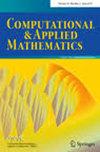渗透微波脱水过程中耦合质量和能量平衡的数值解
IF 2.5
3区 数学
Q1 MATHEMATICS, APPLIED
引用次数: 5
摘要
对渗透微波干燥过程的质能传递进行了理论研究。为了描述复合脱水过程中发生的输运现象,求解了质量和能量的微观平衡。渗透-扩散模型用于渗透脱水(OD)。另一方面,利用温度、水分和可溶性固形物含量对微波干燥过程的质量和热平衡进行建模。得到的平衡形成高度耦合的非线性微分方程,用数值方法求解。对于渗透脱水,质量平衡形成耦合常微分方程,用四阶龙格库塔法求解。在微波干燥情况下,平衡构成偏微分方程,用Crank-Nicolson隐式有限差分法求解。数值方法在Matlab 7.2 (Mathworks, Natick, MA)中编码。所建立的数学模型可以预测复合脱水过程中温度和水分的演变。数学学科分类:初级:06B10;二级:06 d05。本文章由计算机程序翻译,如有差异,请以英文原文为准。
Numerical solution of coupled mass and energy balances during osmotic microwave dehydration
The mass and energy transfer during osmotic microwave drying (OD-MWD) process was studied theoretically by modeling and numerical simulation. With the aim to describe the transport phenomena that occurs during the combined dehydration process, the mass and energy microscopic balances were solved. An osmotic-diffusional model was used for osmotic dehydration (OD). On the other hand, the microwave drying (MWD) was modeled solving the mass and heat balances, using properties as function of temperature, moisture and soluble solids content. The obtained balances form highly coupled non-linear differential equations that were solved applying numerical methods. For osmotic dehydration, the mass balances formed coupled ordinary differential equations that were solved using the Fourth-order Runge Kutta method. In the case of microwave drying, the balances constituted partial differential equations, which were solved through Crank-Nicolson implicit finite differences method. The numerical methods were coded in Matlab 7.2 (Mathworks, Natick, MA). The developed mathematical model allows predict the temperature and moisture evolution through the combined dehydration process. Mathematical subject classification: Primary: 06B10; Secondary: 06D05.
求助全文
通过发布文献求助,成功后即可免费获取论文全文。
去求助
来源期刊

Computational & Applied Mathematics
Mathematics-Computational Mathematics
CiteScore
4.50
自引率
11.50%
发文量
352
审稿时长
>12 weeks
期刊介绍:
Computational & Applied Mathematics began to be published in 1981. This journal was conceived as the main scientific publication of SBMAC (Brazilian Society of Computational and Applied Mathematics).
The objective of the journal is the publication of original research in Applied and Computational Mathematics, with interfaces in Physics, Engineering, Chemistry, Biology, Operations Research, Statistics, Social Sciences and Economy. The journal has the usual quality standards of scientific international journals and we aim high level of contributions in terms of originality, depth and relevance.
 求助内容:
求助内容: 应助结果提醒方式:
应助结果提醒方式:


